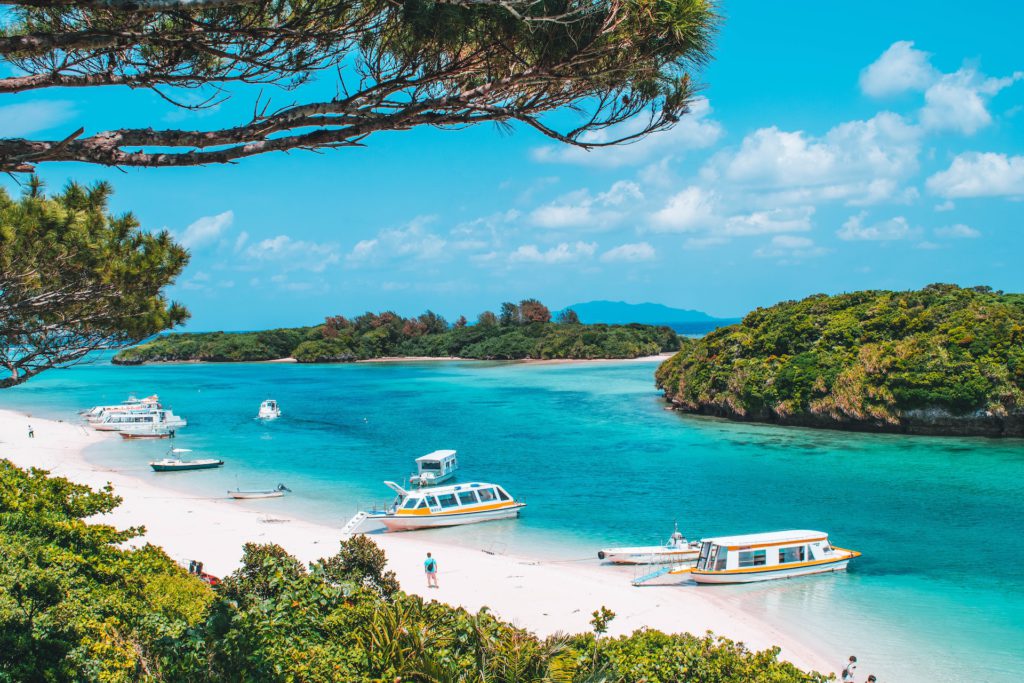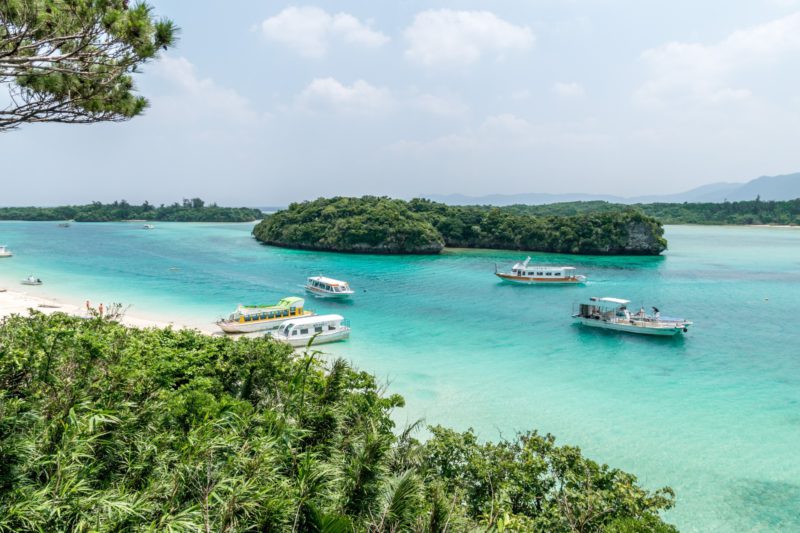Table of Contents
Think of Japan and a metropolis comes to mind. From towering skyscrapers to high-speed bullet trains, cities like Tokyo exude a buzz of constant hustle and bustle. Hit pause and escape the city to Japan’s idyllic Ishigaki Island.

Ishigaki is the main island and only urban center of the Yaeyama Islands, an archipelago in the southwest of Okinawa Prefecture. Apart from being the region’s main airport and ferry terminal, Ishigaki Island is also home to gorgeous white sand beaches, colorful underwater dive sites, and local restaurants that serve some of the best Okinawan cuisines. Combined with the island’s scenic sights and accessibility, Ishigaki is a must-visit destination for a unique paradise experience in Japan.
Best time to visit
The best time to visit Ishigaki Island is from summer to early autumn (June to October). While the weather will be sunny most of the time, you may experience an occasional tropical downpour. We advise that you pack waterproof gear with you before visiting the island.
How to get there
Ishigaki Airport offers direct flights to and from Tokyo, Osaka, and Nagoya. Seasonally, several flights to and from Fukuoka and within the Okinawa Prefecture are available. Some international flights are available as well.
Getting around
Rental car
Renting a car to get around Ishigaki Island is our recommended means of transportation. You can find outlets for all major Japanese car rental companies on the island.
Bus
Buses operate frequently from Ishigaki airport to central Ishigaki. The direct bus only stops at the airport and the ferry terminal in the city center, while other buses make several stops between the airport and the city center.
Taxi
A taxi ride from the airport to the city center takes about 30 minutes and costs around 3,000 yen.
Where to go
Kabira Bay
Located on the north coast of Ishigaki Island, Kabira Bay is known for its unparalleled beauty with its white sands and emerald green waters. Depending on the time of day, the bay becomes a spectacle for the eyes with the waters shifting between hues of blue and green. Kabira Bay is known for a phenomenon called the Manta Scramble where manta rays gather during summer and early autumn to feed on the bay’s nutrient-rich waters. Dive with these graceful creatures and explore the colorful collection of coral reef gardens.
Yonehara Beach
Yonehara Beach is one of the most beautiful beaches on Ishigaki Island. Known for its crystal-clear waters and coral reefs teeming with tropical marine life, Yonehara Beach has earned its spot as the best place to snorkel on the island. The beach is relatively wide and shallow, allowing you to walk straight up to the coral reefs during low tide. Shower facilities, a snorkeling equipment rental store, and lockers are available on the beach.
Miyara River
Designated as a national natural monument in 1972, the Miyara River is the largest river on Ishigaki Island. The river’s riverbanks have been mostly left untouched, allowing for more than 35 kilometers of lush green mangrove forests to grow along the river. These mangrove forests are a habitat and breeding ground for a wide variety of wildlife. Many tours allow you to explore the river and its mangroves by kayaking or on a standup paddleboard (SUP) to help you access hidden caves.
Ishigaki Yaima Village
The Ishigaki Yaima Village is a collection of well-preserved traditional houses that tells the history of Okinawan life from over 100 years ago. The charming village allows visitors to explore Yaima culture through various activities. These include daily song and dance performances, a tour through Yaeyama-style red-tile roof huts, and Ryukyu traditional costumes to try on for the perfect Instagram photo.
Apart from being immersed in history, get acquainted with over 40 adorable squirrel monkeys that call this village home. These friendly creatures would often come up to visitors for food. Visitors can feed them with food from a gachapon machine at the village entrance.
Mt. Omoto
Mt. Omoto is the highest mountain in the Okinawa Prefecture, standing at an elevation of 525.5 meters above sea level. The full trail is six kilometers long and it takes around 90 minutes to hike to the summit. Upon reaching the peak, be rewarded with an unobstructed view of Ishigaki and the neighboring Yaeyama Islands. We recommend conquering this trail with a guide as the route can get steep and slippery in certain areas.
If you’d love to explore more of Japan’s hiking trails, check out our guide to the ancient Kumano Kodo pilgrimage route here.
What to eat
Ishigaki beef
Sink your teeth into pure melt-in-your-mouth goodness. Ishigaki cattle are specially bred in large green pastures on the subtropical climate of Ishigaki. Only 600 to 800 cattle are produced each year. Ishigaki beef is known for its intricate marbling, lending to a succulent and rich flavor. Experience the umami flavor of this irresistible dish prepared in the form of grilled steak, sukiyaki, or shabu shabu.
Try it here: Get a taste of Ishigaki beef at Ishinagi-Ya, a popular restaurant that specializes in preparing Ishigaki beef.
Ishigaki chili oil
While chili oil may seem out of place in Japanese cuisine, Ishigaki’s famous chili oil is a unique specialty that has created waves throughout the Japanese food scene. This chili oil is made with a unique blend of peppers grown in the subtropical climate of Ishigaki. This gourmet chili oil packs a punch and is an ideal complement to dumplings, tofu, and soup.
Try it here: Penguin Shokudo, made famous by the Japanese movie Penguin Fufu, serves up a selection of delicious Japanese-Chinese cuisine. They are best known for mapo tofu made with locally-made tofu and Ishigaki chili oil.
Yaeyama soba
DSCF2045-1024x682.jpg)
Yaeyama soba is one of Ishigaki’s most traditional dishes. The dish features a hearty clear broth topped with pork slices, fish cakes, and green onions. These bouncy soba noodles are made with flour, a departure from the traditional buckwheat soba commonly found on the mainland. Do as the locals do by adding some locally-made Ishigaki chili oil for extra oomph!
Try it here: Gushuan is a local Ishigaki restaurant that serves some of the best authentic Yaeyama soba.
Awamori
If we had to choose a drink that encapsulates the essence of Okinawa, we’d choose awamori, a delightful island sake locally produced in Okinawa. Awamori has a history that dates back to the Ryukyu Kingdom and was first introduced to Okinawa from Thailand. Awamori is light on the tongue and has a distinctive taste that sets it apart from typical sake due to its main ingredients: Thai rice and black koji mold.
Presently, variations of this well-loved drink can be found at the 46 distilleries across the prefecture.
Try it here: Learn about and get a taste of awamori at the Seifuku Distillery’s Awamori Museum, a distillery with over 60 years of history on Ishigaki island.
Sata andagi
Sata andagi is an Okinawan sweet donut snack that is crispy on the outside and soft and fluffy on the inside. The star ingredient of sata andagi is black molasses, which gives this treat its smokey flavor. Commonly found at coffee shops, markets, street festivals, and restaurants, this beloved Okinawan treat comes plain or as a sweet potato flavor.
Try it here: Try your hands at making sata andagi at Ishigaki Yaima Village, or find them ready-made at the gift shop.
About TourHero
TourHero is a social travel platform that enables you to travel with like-minded people and fall in love with the journey. We work closely with handpicked local operators to ensure every experience curated is unique and exclusive to your travel group. Come with us on epic adventures and create memories that last a lifetime!








